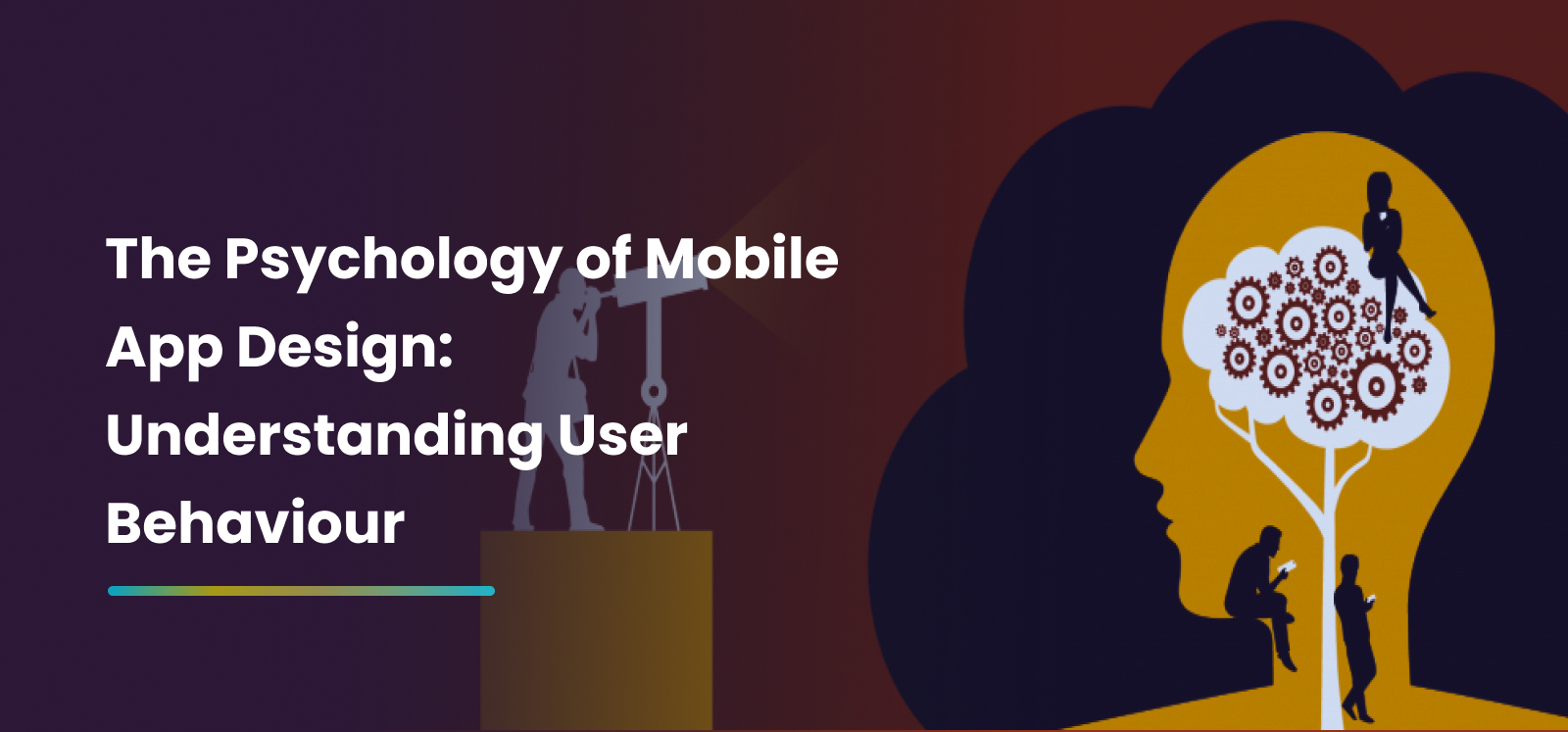22 June 2023
Published by

Table of Contents
⦁ Introduction: The Power of Mobile Apps
⦁ The Role of Psychology in App Design
⦁ Understanding User Behavior
⦁ Attention and Focus
⦁ Cognitive Load
⦁ Visual Appeal
⦁ Navigating User Experience
⦁ Intuitive Navigation
⦁ Simplified Onboarding Process
⦁ Personalization and Customization
⦁ The Influence of Feedback and Rewards
⦁ Instant Gratification
⦁ Gamification Elements
⦁ Social Validation
⦁ Building Trust and Credibility
⦁ User-Friendly Design
⦁ Transparent Data Practices
⦁ Security Measures
⦁ Emotional Design and User Engagement
⦁ Creating Emotional Connections
⦁ Delightful Micro interactions
⦁ Evoking Positive Emotions
⦁ Optimizing Performance and Speed
⦁ Seamless User Experience
⦁ Minimizing Loading Times
⦁ Efficient Resource Management
⦁ The Future of Mobile App Design
⦁ Conclusion
⦁ FAQs

Introduction:
1. The Power of Mobile Apps.
Mobile applications have revolutionized the way we interact with technology. With billions of smartphone users worldwide, apps have become a significant part of our daily routine. From entertainment to productivity, mobile apps provide convenience and accessibility at our fingertips.
2. The Role of Psychology in App Design.
Mobile app design goes beyond aesthetics and functionality. It incorporates psychological principles to create an engaging and satisfying user experience. By understanding how users think, feel, and behave, app designers can tailor their creations to meet users’ needs and desires effectively.
3. Understanding User Behavior.
To design an app that resonates with users, it is crucial to understand their behavior. Here are three key factors that influence user behavior in the context of mobile apps:
4. Attention and Focus.
In a world filled with distractions, capturing and maintaining users’ attention is essential. Effective app design employs techniques such as compelling visuals, concise content, and well-placed call-to-action buttons to keep users engaged and focused.
5.Cognitive Load.
Users prefer apps that are easy to navigate and understand. Minimizing cognitive load by using intuitive icons, clear instructions, and straightforward layouts enhances the user experience. By reducing mental effort, users are more likely to enjoy using the app and return to it frequently.
1.1 Emotional Design and User Engagement
Emotions play a significant role in shaping user experiences and driving engagement. Here are three strategies for incorporating emotional design into mobile app experiences:
A. Creating Emotional Connections
Apps that evoke positive emotions, such as joy, excitement, or nostalgia, establish a deeper connection with users. Emotional design elements, such as delightful animations, interactive elements, or personalized greetings, contribute to a memorable and engaging user experience.
B. Delightful Micro interactions
Micro interactions are subtle, single-purpose interactions that enhance user engagement. Examples include animated buttons, loading animations, or sound effects. Well-crafted micro interactions can surprise and delight users, making their interaction with the app more enjoyable.
C. Evoking Positive Emotions
Design choices, such as color palettes, typography, and imagery, can evoke specific emotions. Understanding the emotional impact of different design elements and aligning them with the app’s purpose and target audience can create a more engaging and emotionally resonant experience.
D. Optimizing Performance and Speed
App performance and speed are crucial factors in user satisfaction. Users expect apps to be fast, responsive, and efficient. Here are three ways to optimize performance:
E. Seamless User Experience
Eliminating unnecessary steps, reducing loading times, and optimizing app responsiveness contribute to a seamless user experience. Designers should prioritize efficient information retrieval and minimize user wait times to ensure smooth and uninterrupted app usage.
F. Minimizing Loading Times
Slow loading times can lead to user frustration and abandonment. Optimizing app loading speeds by compressing images, reducing network requests, and caching data improves the overall user experience. Every second counts when it comes to retaining users’ attention.
G. Efficient Resource Management
App performance can be affected by resource-intensive processes running in the background. Efficient resource management, such as properly handling memory usage and optimizing battery consumption, ensures that the app runs smoothly and does not drain device resources excessively.
H. Visual Appeal
Humans are visually-oriented beings, and aesthetics play a crucial role in app design. Eye-catching colors, visually pleasing graphics, and a well-balanced layout can make an app visually appealing and memorable. Striking the right balance between simplicity and sophistication is key to creating an engaging visual experience.
2.1 Navigating User Experience
A seamless and intuitive user experience is a hallmark of successful mobile apps. Here are three elements that contribute to a smooth user experience:
A. Intuitive Navigation
Users appreciate apps that are easy to navigate. Clear and logical menu structures, intuitive gestures, and well-organized content enable users to navigate the app effortlessly. Designers should prioritize simplicity and avoid overwhelming users with complex navigation systems.
B. Simplified Onboarding Process
First impressions matter. An onboarding process that is simple, informative, and interactive can make a significant difference in user engagement. By guiding users through initial app interactions and highlighting key features, designers can help users quickly grasp the app’s value and purpose.
C. Personalization and Customization
Users value personalized experiences. Allowing users to customize app settings, personalize content, and tailor the user interface to their preferences enhances engagement and creates a sense of ownership.
3.1 The Influence of Feedback and Rewards
Feedback and rewards are powerful tools for user engagement and motivation. Here are three ways in which they influence user behavior:
A. Instant Gratification
Providing immediate feedback or rewards when users accomplish tasks or reach milestones boosts their motivation and satisfaction. Small celebratory animations, badges, or progress bars can create a sense of achievement and encourage users to continue using the app.
B. Gamification Elements
Gamification elements, such as leaderboards, challenges, and rewards systems, add an element of fun and competition to app usage. By incorporating game-like features, designers can tap into users’ intrinsic motivation and drive long-term engagement.
C. Social Validation
Humans are social beings who seek validation from others. Integrating social features into an app, such as sharing achievements or connecting with friends, allows users to engage with their social networks and receive validation.
4.1 Building Trust and Credibility
Trust and credibility are essential for the success of any mobile app. Designers must prioritize the following aspects to establish trust:
A. User-Friendly Design
An app that is easy to use and understand builds trust with users. Consistent design elements, clear labeling, and intuitive interactions contribute to a positive user experience. Building trust through design enhances the app’s reputation and fosters long-term user loyalty.
B. Transparent Data Practices
Users are increasingly concerned about their data privacy and security. Apps that are transparent about their data practices and provide clear privacy policies instill confidence in users.
C. Security Measures
Mobile app security is paramount. Implementing encryption protocols, secure login processes, and regular security updates reassures users that their data and personal information are protected.
5.1 Emotional Design and User Engagement
Emotions play a significant role in shaping user experiences and driving engagement. Here are three strategies for incorporating emotional design into mobile app experiences:
A. Creating Emotional Connections
Apps that evoke positive emotions, such as joy, excitement, or nostalgia, establish a deeper connection with users. Emotional design elements, such as delightful animations, interactive elements, or personalized greetings, contribute to a memorable and engaging user experience.
B. Delightful Micro interactions
Micro interactions are subtle, single-purpose interactions that enhance user engagement. Examples include animated buttons, loading animations, or sound effects. Well-crafted micro interactions can surprise and delight users, making their interaction with the app more enjoyable.
C. Evoking Positive Emotions
Design choices, such as color palettes, typography, and imagery, can evoke specific emotions. Understanding the emotional impact of different design elements and aligning them with the app’s purpose and target audience can create a more engaging and emotionally resonant experience.
6.1 Optimizing Performance and Speed
App performance and speed are crucial factors in user satisfaction. Users expect apps to be fast, responsive, and efficient. Here are three ways to optimize performance:
A. Seamless User Experience
Eliminating unnecessary steps, reducing loading times, and optimizing app responsiveness contribute to a seamless user experience.
B. Minimizing Loading Times
Slow loading times can lead to user frustration and abandonment. Optimizing app loading speeds by compressing images, reducing network requests, and caching data improves the overall user experience. Every second counts when it comes to retaining users’ attention.
C. Efficient Resource Management
App performance can be affected by resource-intensive processes running in the background. Efficient resource management, such as properly handling memory usage and optimizing battery consumption, ensures that the app runs smoothly and does not drain device resources excessively.
The Future of Mobile App Design
As technology continues to evolve, so does mobile app design. Future trends include augmented reality integration, voice interactions, and seamless cross-platform experiences. Designers will need to adapt to new technologies and user expectations to create innovative and engaging app experiences.
Conclusion
Understanding the psychology of mobile app design is essential for creating successful and engaging applications. By incorporating principles such as attention and focus, intuitive navigation, feedback and rewards, trust and credibility, emotional design, and optimized performance, designers can create apps that captivate users and provide exceptional user experiences.
FAQs
⦁ Q: How important is user experience in mobile app design?
A: User experience is paramount in mobile app design. It directly influences user satisfaction, engagement, and retention.
⦁ Q: What are some common mistakes to avoid in mobile app design?
A: Common mistakes include complex navigation, cluttered interfaces, slow loading times, and neglecting user feedback.